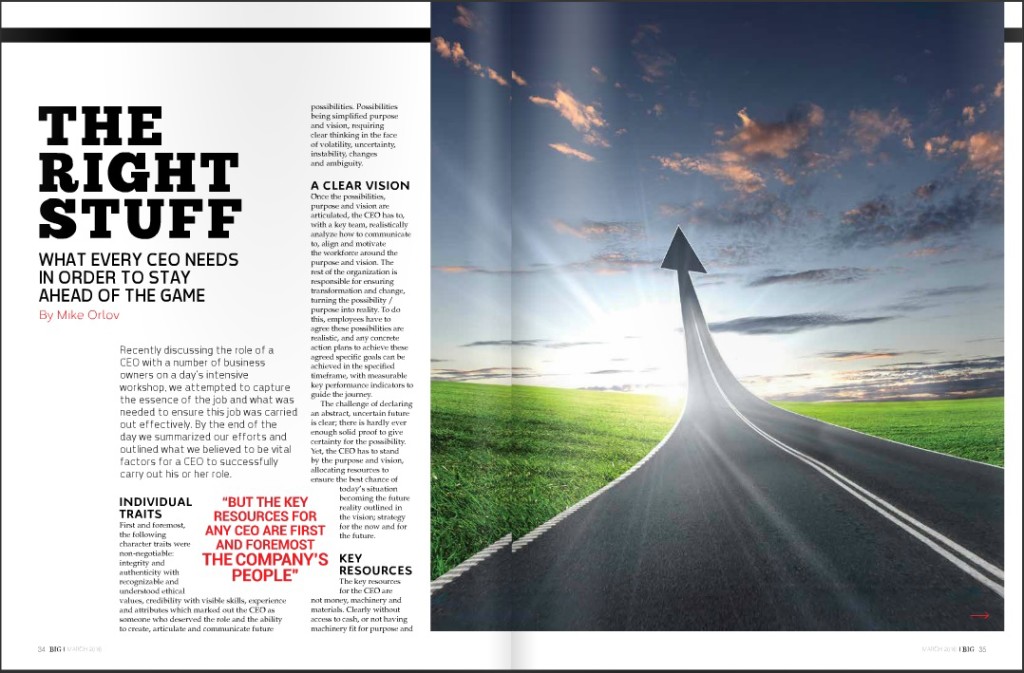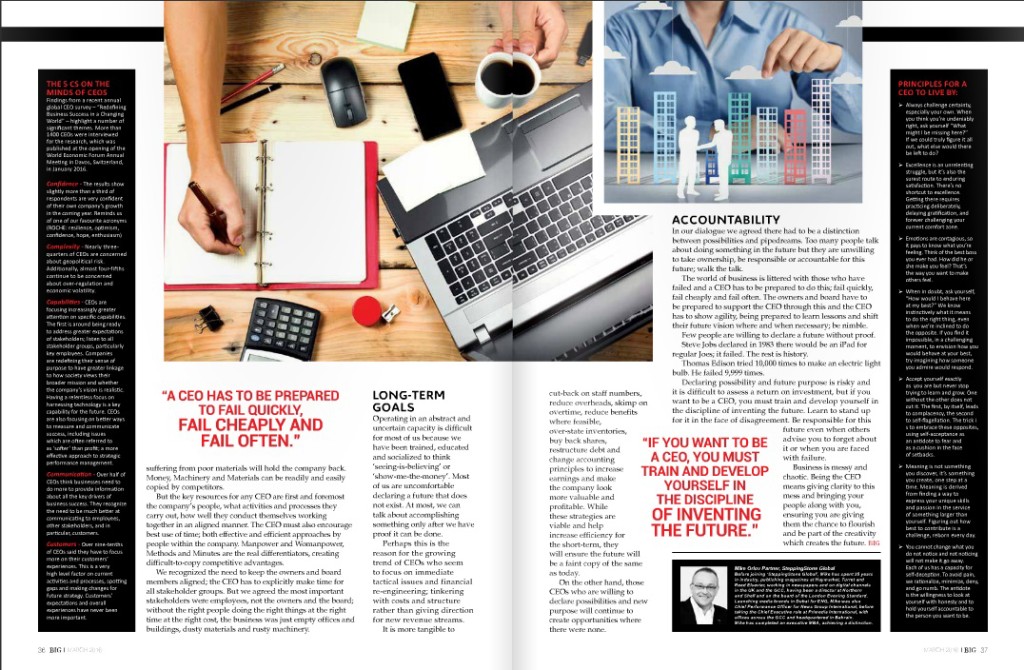
So You Want To Be a CEO…
Recently discussing the role of a CEO with a number of business owners on a day’s intensive workshop, we attempted to capture the essence of the job and what was needed to ensure this job was carried out effectively. By the end of the day we summarized our efforts and outlined what we believed to be vital factors for a CEO to successfully carry-out their role.
First and foremost, the following character traits were non-negotiable: integrity and authenticity with recognizable and understood ethical values, credibility with visible skills, experience and attributes which marked out the CEO as someone who deserved the role and the ability to create, articulate and communicate future possibilities. Possibilities being simplified purpose and vision, requiring clear thinking in the face of volatility, uncertainty, instability, changes and ambiguity.
Once the possibilities, purpose and vision are articulated, the CEO has to, with a key team, realistically analyze how to communicate to, align and motivate the workforce around the purpose and vision. The rest of the organization is responsible for ensuring transformation and change, turning the possibility / purpose into reality. To do this, employees have to agree these possibilities are realistic, and any concrete action plans to achieve these agreed specific goals can be achieved in the specified timeframe, with measurable key performance indicators to guide the journey.
The challenge of declaring an abstract, uncertain future is clear; there is hardly ever enough solid proof to give certainty for the possibility. Yet, the CEO has to stand by the purpose and vision, allocating resources to ensure best-chance of today’s situation becoming the future reality outlined in the vision; strategy for the now and for the future.

The key resources for the CEO are not money, machinery and materials. Clearly without access to cash, or not having machinery fit for purpose and suffering from poor materials will hold the company back. Money, Machinery and Materials can be readily and easily copied by competitors.
But the key resources for any CEO are first and foremost the company’s people, what activities and processes they carry out, how well they conduct themselves working together in an aligned manner. The CEO must also encourage best use of time; both effective and efficient approaches by people within the company. Manpower and Womanpower, Methods and Minutes are the real differentiators, creating difficult-to-copy competitive advantages.
We recognized the need to keep the owners and board members aligned; the CEO has to explicitly make time for all stakeholder groups. But we agreed the most important stakeholders were employees, not the owners and the board; without the right people doing the right things at the right time at the right cost, the business was just empty offices and buildings, dusty materials and rusty machinery.
Operating in an abstract and uncertain capacity is difficult for most of us because we have been trained, educated and socialized to think ‘seeing-is-believing’ or ‘show-me-the-money’. Most of us are uncomfortable declaring a future that does not exist. At most, we can talk about accomplishing something only after we have proof it can be done.
Perhaps this is the reason for the growing trend of CEOs who seem to focus on immediate tactical issues and financial reengineering; tinkering with costs and structure rather than giving direction for new revenue streams.
It is more tangible to cut-back on staff numbers, reduce overheads, skimp on overtime, reduce benefits where feasible, over-state inventories, buy back shares, restructure debt and change accounting principles to increase earnings and make the company look more valuable and profitable. While these strategies are viable and help increase efficiency for the short-term, they will ensure the future will be a faint copy of the same as today.
On the other hand, those CEOs who are willing to declare possibilities and new purpose will continue to create opportunities where there were none.
In our dialogue we agreed there had to be a distinction between possibilities and pipedreams. Too many people talk about doing something in the future but they are unwilling to take ownership, be responsible or accountable for this future; walk the talk.
The world of business is littered with those who have failed and a CEO has to be prepared to do this; fail quickly, fail cheaply and fail often. The owners and board have to be prepared to support the CEO through this and the CEO has to show agility, being prepared to learn lessons and shift their future vision where and when necessary; be nimble.
Few people are willing to declare a future without proof.
Steve Jobs declared in 1983 there would be an iPad for regular Joes; it failed. The rest is history.
Thomas Edison tried 10,000 times to make an electric light bulb. He failed 9,999 times.
Declaring possibility and future purpose is risky and it is difficult to assess a return on investment, but if you want to be a CEO, you must train and develop yourself in the discipline of inventing the future. Learn to stand up for it in the face of disagreement. Be responsible for this future even when others advise you to forget about it or when you are faced with failure.
Business is messy and chaotic. Being the CEO means giving clarity to this mess and bringing your people along with you, ensuring you are giving them the chance to flourish and be part of the creativity which creates the future.
The 5 Cs on the Minds of CEOs
Findings from a recent annual global CEO survey – “Redefining Business Success in a Changing World” – highlight a number of significant themes. More than 1,400 CEOs were interviewed for the research, which was published at the opening of the World Economic Forum Annual Meeting in Davos, Switzerland, in January 2016.
Confidence – The results show slightly more than a third of respondents are very confident of their own company’s growth in the coming year. Reminds us of one of our favorite acronyms (ROCHE: resilience, optimism, confidence, hope, enthusiasm)
Complexity – Nearly three quarters of CEOs are concerned about geopolitical risk. Additionally, almost four fifths continue to be concerned about over-regulation and economic volatility. Another acronym jumps to mind (STEEPLE: social factors, technological disruptions, economic instability, ecological pressures, legal disturbances, political unrest, ethical ambiguities)
Capabilities – CEOs are focusing increasingly greater attention on specific capabilities. The first is around being ready to address greater expectations of stakeholders; listen to all stakeholder groups, particularly key employees. Companies are redefining their sense of purpose to have greater linkage to how society views their broader mission and whether the company’s vision is realistic. Having a relentless focus on harnessing technology is a key capability for the future. CEOs are also focusing on better ways to measure and communicate success, including issues which are often referred to as ‘softer’ than profit; a more effective approach to strategic performance management.
Communication – Over half of CEOs think businesses need to do more to provide information about both all the key drivers of business success. They recognize the need to be much better at communicating to employees, other stakeholders, in particular customers.
Customers – Over nine tenths of CEOs said they have to focus more on their customers’ experiences. This is a very high level factor on current activities and processes, spotting gaps and making changes for future strategy. Customers’ expectations and overall experiences have never been more important.
Three Key Factors for Good CEOs: time should be spent on:
- Setting the overall purpose, vision and strategy of the company and communicating this to all stakeholders
- Recruit, hire, and retain the very best talent for the company, releasing their creativity, imagination and efforts
- Make sure your finance team is ensuring there is always enough cash in the bank
So You Want To Be A CEO
What enduring principles can you rely on to make choices that reflect integrity, authenticity and credibility?
- Always challenge certainty, especially your own. When you think you’re undeniably right, ask yourself “What might I be missing here?” If we could truly figure it all out, what else would there be left to do?
- Excellence is an unrelenting struggle, but it’s also the surest route to enduring satisfaction. There’s no shortcut to excellence. Getting there requires practicing deliberately, delaying gratification, and forever challenging your current comfort zone
- Emotions are contagious, so it pays to know what you’re feeling. Think of the best boss you ever had. How did he or she make you feel? That’s the way you want to make others feel
- When in doubt, ask yourself, “How would I behave here at my best?” We know instinctively what it means to do the right thing, even when we’re inclined to do the opposite. If you find it impossible, in a challenging moment, to envision how you would behave at your best, try imagining how someone you admire would respond.
- Accept yourself exactly as you are but never stop trying to learn and grow. One without the other does n0t cut it. The first, by itself, leads to complacency, the second to self-flagellation. The trick is to embrace these opposites, using self-acceptance as an antidote to fear and as a cushion in the face of setbacks
- Meaning is not something you discover, it’s something you create, one step at a time. Meaning is derived from finding a way to express your unique skills and passion in the service of something larger than yourself. Figuring out how best to contribute is a challenge, reborn every day
- You cannot change what you do not notice and not noticing will not make it go away. Each of us has a capacity for self-deception. To avoid pain, we rationalize, minimize, deny, and go numb. The antidote is the willingness to look at yourself with honesty and to hold yourself accountable to the person you want to be
- Take Ownership, exhibit Responsibility and be Accountable
